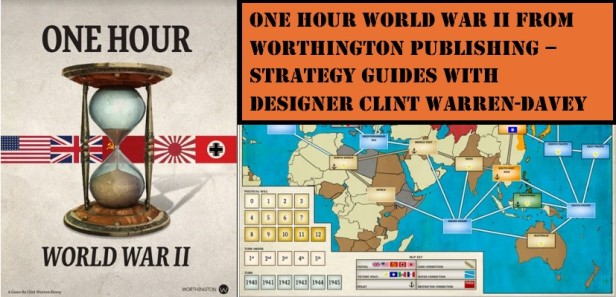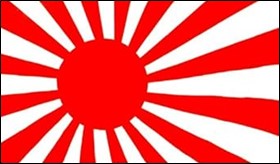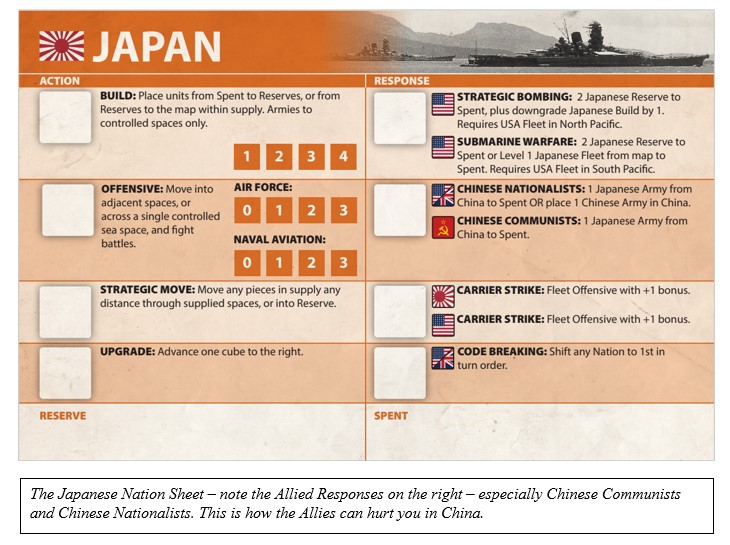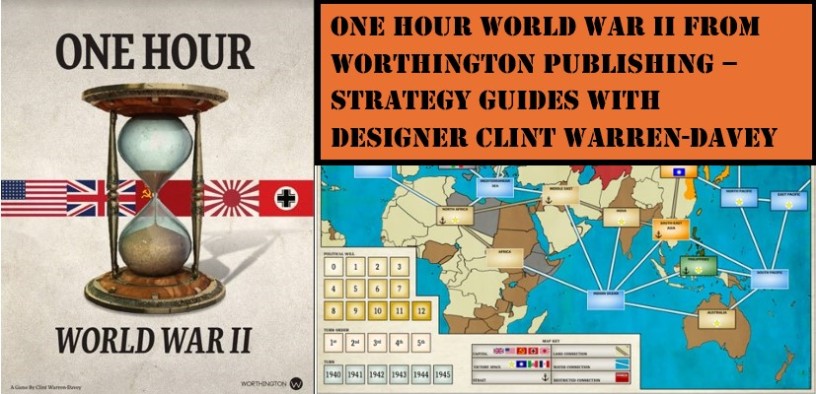In this series of articles, we are looking at the overall strategy recommendations for the very interesting and unique strategic level wargame One Hour World War II from Worthington Publishing. This is general tactical consideration advice for the various factions in the game and will be of interest to anyone who might want to better understand the framework of the design around which the game focuses. The images used here are prototypes and not necessarily the final product. For this 4th article, we are focusing on Japan.

Japan Strategy Guide

Japan is in an interesting position in One Hour World War II. Far from the center of attention in Europe, it is nonetheless poised to grab a large number of victory spaces and contribute more than its fair share to an Axis victory. Japan starts with two key advantages – it is the only Nation with a Level 2 Fleet on the board and the only Nation with Naval Aviation starting at 1. It has the naval power to totally dominate the Pacific and thereby have access to victory spaces like Australia and the Philippines. It also has no immediate threats – the USA is the only country that can seriously challenge it and the Americans are not at all ready for war in 1940 or 1941.

Opening Moves
At the start of the game, the Asia-Pacific is wide open to conquest. China is weak and isolated, the British colonies are virtually undefended and the USA has a single Fleet in the East Pacific, totally unable to threaten you. The Soviet Union has a an Army in Siberia, but they start the game with a single Action and will need to focus 90% of their attention on Germany. You must take advantage of enemy weakness while it lasts – eventually the USA will enter the fight and things will get a lot harder. There are basically four targets you can focus on:
-China
-India
-South Pacific
-The US Navy
Let’s look at each of these in turn.
China
The most immediate and obvious target for Japanese expansion is China. Here, you start the game with an Army already in place facing off against a single Chinese Army under USA control. The other Army in Japan itself can easily be brought in, as the Japanese player treats China and Japan as adjacent. Now, China counts as Japanese Home Territory, so taking full control of it will not exactly help you during scoring. But holding China will prevent the Allies taking control of a victory space and it keeps your land-based supply line to South-east Asia open.
So, an obvious move on the very first Japanese Action is to launch an Offensive into China, using the Army already there plus the Army in Japan itself. Your initial strength will be 2, so it is worth committing a Reserve to boost this to 3 as the USA player can commit their single Chinese Army in Reserve to increase the Allied strength to 2 in this fight. Now, when you launch this initial Offensive the enemy may respond. The Soviets can use the Chinese Communists Response while the UK and USA can choose the Chinese Nationalists Response. Both of them can remove a Japanese Army from China, while the Chinese Nationalists may instead place a Chinese Army (under US control) in China. This means that if all 3 Allied Nations work together and use these Responses at the same time, they can remove two Japanese Armies and place one Chinese Army, regaining control of China even after a major commitment of force by Japan in the first turn. If this happens, it will affect your long-term strategy. You cannot allow the Allies to control China for the whole game – from 1940 to 1945 it can earn them a difference of 6 (!) in terms of Political Will. It also controls your only land-based supply line to Asia. So, if you have the Actions to spare, build up again and take it as soon as possible. Upgrading your Air Force track before going into China is a good idea – this makes it easier to get the critical 3:1 ratio and therefore permanently kill a Chinese Army.
One more thing should be mentioned regarding the Chinese front. It is the only place where the Soviet Union can attack you. Very often, especially late in the game, the Soviets will launch an Offensive from Siberia into China. They may be combining their strength with Chinese Armies already there, making it even harder. Now, there are not many things you can do to stop this. The Soviet Union will be a major threat in the late game (provided that the Allies have contained Germany) and you cannot match it in terms of sheer numbers. Upgrading your Air Force track as much as possible is the best way to deter the Soviet menace, but an often-overlooked alternative is to attack Siberia. This could be done early in the game in the hopes of getting a 3:1 ratio and permanently killing the Soviet Army which starts there. Or it could be done later when the Soviets have moved this Army away. Either way, attacking Siberia serves the same purpose – putting some distance between Soviet forces and the important victory space of China.

India
India is a great early game target for the Japanese, especially if the Germans have cut off Britain from its empire by taking North Africa. It is a victory space, and one of the few which Japan can reach without having to cross the sea. Within 2 Actions you can take it – Build an Army in South-east Asia, then Offensive into India. Often the British will see this vulnerability and use Build, perhaps combined with their Commonwealth Response, to place one or two Armies in India early in the game. If they do this, you have two choices. First, you could upgrade your Air Force track until you have superior strength to the garrison of the Raj. The British player may get into a bit of an arms race with you and prevent you taking India – but this is not all bad. It may take pressure off the Germans, who can then grab victory spaces elsewhere on the map. Alternatively, you can pivot your strategy and target somewhere else. Just keep an Army in South-east Asia to maintain the threat, so that the UK can’t just abandon India entirely and use their forces elsewhere.
South Pacific
An excellent early game move is Building a Fleet in the South Pacific, before the Americans can do the same thing. This gives you access to Australia and the Philippines, easy victory spaces which will rarely have an Army defending them. Holding the South Pacific also denies the USA player the chance to use Submarine Warfare Response, which can sink your Fleets very easily. Provided the Allies don’t bog you down in China with their Responses, you can end the 1940 turn in a very strong position. For your first Action, Offensive into China. For your second Action, build a Fleet in the South Pacific and an Army in South-east Asia, both from Reserve. Now at the start of 1941 you have a choice of 3 targets to attack: India, Australia or the Philippines. Chances are at least 1 of them will be totally undefended. If the USA has built a Fleet in the South Pacific, you can still enact this plan by building a Fleet in the Indian Ocean. The UK may have placed a Fleet here though, so this is not always an option.

The USA – Awakening the sleeping giant…
Inevitably, you will have to come to grips with the USA. They are the only Allied Nation which can really threaten you directly and take away your victory spaces. They also possess two victory spaces which you will want to take – the East Pacific and the Philippines. They start very weak – with a single Fleet and a single Action in 1940. They will get stronger though, gaining an Action marker every turn from 1941 to 1944. They also have huge numbers of units to deploy, including two Level 2 Fleets. Now, a lot of this combat power is going to be headed towards Germany and not you. But in many games the USA will be at the very least trying to contain you, if not destroy you completely.
Now, a highly relevant rule here is the special “Axis Attack” USA Action marker. This Action marker is given to the USA as soon as an Axis Nation launches an Offensive against USA units or Home Territory. This represents the enormous outpouring of patriotism and unity behind the war effort triggered by the attack on Pearl Harbor. However, if the USA attacks an Axis Nation first, they forfeit this marker for the whole game. The game assumes that the USA will inevitably enter the Second World War at some point, but if it does so before a significant Axis attack on American soil the population will be far less inclined to support it. Now, the action economy in One Hour World War II is extremely tight. A single Action each turn is huge – Japan itself only has two per turn for the entire game! If you attack the USA in 1940, you are giving them six extra Actions over the course of the game. If you attack them in 1941, you are giving them five extra Actions. 1942, four Actions. And so on. This benefit to the Allies must be weighed up against the opportunity to grab victory spaces and destroy American Fleets, perhaps permanently. For example, if a single Offensive in 1941 or 1942 can permanently destroy a Level 2 USA Fleet and take control of the East Pacific for two turns, it may well be worth handing the American player an extra four Actions.
The other factor to consider is the overall strategy being pursued by the Axis. If you and Germany together decide to go for an auto-win by reducing Allied Political Will to zero, you can both go all-out for Allied victory spaces regardless of the cost. Imagine a situation where Germany takes the Balkans, France and North Africa in 1940 and 1941, while you take East Pacific, Philippines and Australia by 1942. There is a good chance you will win by the end of the 1942 turn. This means those extra American Actions will not make a difference. Of course, if you miscalculate this and don’t pull off the auto-win, this strategy can go disastrously wrong. You and Germany will be overstretched and will need to pull back into a defensive position rapidly. The Americans will be coming for you!

Defending the homeland
If the USA starts going after you, the game is far from lost. You can make them pay for every inch of ground taken in the Pacific Theatre. If the Allies are going for a capital victory – taking both Germany and Japan – it is entirely possible to hold them off. So how do you do this?
First, maintain control of the sea for as long as you can. The only way to invade Japan is to control the North Pacific. If you upgrade your Naval Aviation a few times and stack two or even three Fleets there, the USA will find it nearly impossible to break through. The Island Defense Response can help you hold out even longer by recycling Armies or Fleets back onto the map. The USA will have to devote an extra Action marker to their Marine Corps Response to cancel this. If they do commit to wiping out your Fleet, you will see it coming and can prepare. While supply lines are still open, you can Strategic Move your Armies from various land spaces back to Japan itself. So even if the Americans destroy the Imperial Japanese Navy they will have to confront the Imperial Japanese Army when they land.
Because it is so difficult to actually pull this off, the Allies will often not even bother going for a capital victory. Instead, they will fight you for victory spaces and try to get higher Political Will by the end of 1945. If they do this, there will be fights throughout the Asia-Pacific, with the Americans most likely trying to retake Philippines and/or Australia from you. Again, the navy is crucial. A single Japanese Fleet in the South Pacific prevents any amphibious assault on Australia or the Philippines. Maxing out Naval Aviation in the mid-game will help your ships stay toe-to-toe with the superior American numbers. The Air Force track is also great for making your small, overstretched land forces pack a punch. With a maximum Air Force track (3), each Japanese Army holding a space on the map has an initial strength of 4. If the USA hasn’t upgraded their own Air Force track, they will need to commit three or four of their own Armies just to match you. This will slow them down.
Finally, keep an eye on what Germany is doing and see if you can help them by distracting the USA. Perhaps you can force them to commit an extra Army or two that would be needed in the battle for Berlin. Or deny the Soviets a handy Lend Lease to replenish their forces. You win or lose as a team after all, despite the vast distance between you.
Conclusion
Japan is in position to wreak havoc in the Pacific and grab a slew of victory spaces if left unchecked. If you can take and hold China early on and maintain control of the sea into the mid-game, you are in position to strike at India, Australia and the Philippines. When the USA does come after you in the late game, upgrading your Naval Aviation and maintaining a strong naval force in the North Pacific will let you hold on till the bitter end. Long live the Emperor!
In our next Strategy Guide, which is the conclusion to the series, we will take a look at the United States of America.
If you are interested, you can read our interview with the designer Clint Warren-Davey on the blog to find out more about the design at the following link: https://theplayersaid.com/2024/06/04/interview-with-clint-warren-davey-designer-of-one-hour-wwii-from-worthington-publishing/
And if you are interested in One Hour World War II, you can late back the project on the Kickstarter page at the following link: https://www.kickstarter.com/projects/1456271622/one-hour-world-war-ii?ref
-Grant
